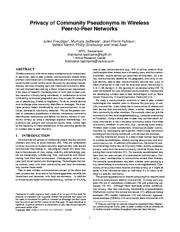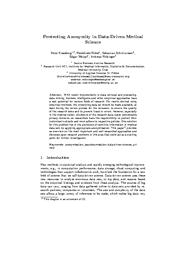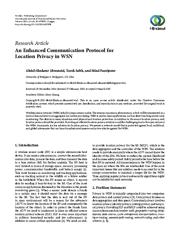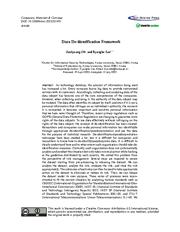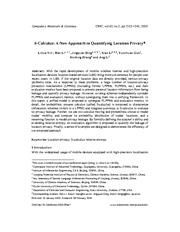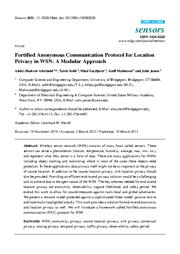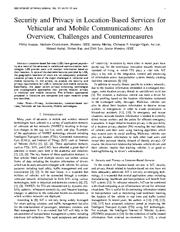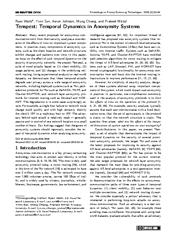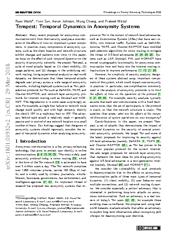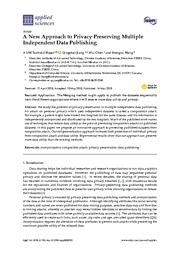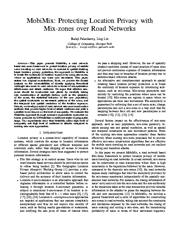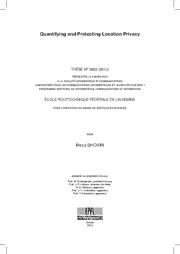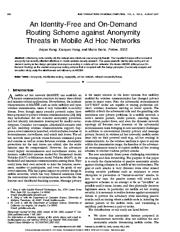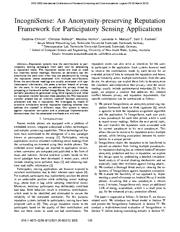A copy of this work was available on the public web and has been preserved in the Wayback Machine. The capture dates from 2017; you can also visit the original URL.
The file type is application/pdf.
Filters
Privacy of Community Pseudonyms in Wireless Peer-to-Peer Networks
2012
Journal on spesial topics in mobile networks and applications
We use the general concept of community pseudonyms to abstract anonymous community identification mechanisms and define two distinct notions of community privacy by using a challenge-response methodology ...
After years of research, the deployment of such peer-to-peer wireless networks is finally being considered. ...
Probabilistic Attacks In probabilistic attacks, the adversary constructs a probabilistic mapping of community pseudonyms P to communities C . ...
doi:10.1007/s11036-012-0406-y
fatcat:ubsldombljdgbicagswqw3yvlm
Protecting Anonymity in Data-Driven Biomedical Science
[chapter]
2014
Lecture Notes in Computer Science
One solution for this problem lies in the protection of sensitive information in medical data sets by applying appropriate anonymization. ...
With recent improvements in data retrieval and processing, data mining, business intelligence and other empirical approaches have a vast potential for various fields of research. ...
Table linkage attacks determine the presence or absence of the record owner, while probabilistic attacks refer to the threat of a change in the general probabilistic belief of the attacker after seeing ...
doi:10.1007/978-3-662-43968-5_17
fatcat:4q3yymgvqvfwpbt5w2sjq3ymnq
An Enhanced Communication Protocol for Location Privacy in WSN
2015
International Journal of Distributed Sensor Networks
Providing an efficient location privacy solution would be challenging due to the open nature of the WSN. Anonymity is a key solution for location privacy. ...
Wireless sensor network (WSN) is built of many sensor nodes. The sensors can sense a phenomenon, which will be represented in a form of data and sent to an aggregator for further processing. ...
Conflict of Interests The authors declare that there is no conflict of interests regarding the publication of this paper. ...
doi:10.1155/2015/697098
fatcat:ndadnkexh5bzzeh6m5hfofjvou
Data De-identification Framework
2023
Computers Materials & Continua
De-identification/pseudonymization techniques have been studied a lot, but it is difficult for companies and researchers to know how to de-identify/pseudonymize data. ...
Accordingly, collecting and analyzing data of the data subject has become one of the core competencies of the companies. ...
Conflicts of Interest: The authors declare that they have no conflicts of interest to report regarding the present study. ...
doi:10.32604/cmc.2023.031491
fatcat:decsef3lpbdqply3vqclx5cifi
δ-calculus: A New Approach to Quantifying Location Privacy☆
2020
Computers Materials & Continua
In LBS, if the original location data are directly provided, serious privacy problems raise. ...
Further, we use two calculus moving and probabilistic choice to model nodes' mobility and compute its probability distribution of nodes' locations, and a renaming function to model privacy leakage. ...
Besides, many efforts are spent on the combination of k-anonymity with pseudonyms. For example, Liao et al. ...
doi:10.32604/cmc.2020.09667
fatcat:mrktga4ferhtzeuav2agngqtta
Fortified Anonymous Communication Protocol for Location Privacy in WSN: A Modular Approach
2015
Sensors
These sensors can sense a phenomenon (motion, temperature, humidity, average, max, min, etc.) and represent what they sense in a form of data. ...
In these applications, data privacy itself might not be as important as the privacy of source location. In addition to the source location privacy, sink location privacy should also be provided. ...
Ideally, the source should update the pseudonyms only after making sure the BS receives the data. ...
doi:10.3390/s150305820
pmid:25763649
pmcid:PMC4435140
fatcat:fjh2mukixzgbfp6f46uiv5mw4y
Security and Privacy in Location-Based Services for Vehicular and Mobile Communications: An Overview, Challenges and Countermeasures
2018
IEEE Internet of Things Journal
In spite of the desirable features provided by LBS, the geographic locations of users are not adequately protected. Location privacy is one of the major challenges in vehicular and mobile networks. ...
Location-based Services (LBS) have gained popularity as a result of the advances in mobile and communication technologies. LBS provide users with relevant information based on their location. ...
Dummy
Dummy-T [32]
Entropy
Inference attacks
Historical data is protected from adver-
saries with background information using
dummy generating algorithm. ...
doi:10.1109/jiot.2018.2820039
fatcat:y2gdcllac5fbpdd2nnxn4tib2i
Tempest: Temporal Dynamics in Anonymity Systems
2018
Proceedings on Privacy Enhancing Technologies
The adversary behind each attack is relatively weak – generally passive and in control of one network location or a small number of hosts. ...
Using experimental analysis on real-world datasets, we demonstrate that these temporal attacks degrade user privacy across a wide range of anonymity networks, including deployed systems such as Tor; pathselection ...
The views expressed in this work are strictly those of the authors and do not necessarily reflect the official policy or position of ONR or NSF. ...
doi:10.1515/popets-2018-0019
dblp:journals/popets/WailsSJCM18
fatcat:e6ckcbpp3zfq7ctq6ydabuazoe
Tempest: Temporal Dynamics in Anonymity Systems
[article]
2018
arXiv
pre-print
The adversary behind each attack is relatively weak - generally passive and in control of one network location or a small number of hosts. ...
Using experimental analysis on real-world datasets, we demonstrate that these temporal attacks degrade user privacy across a wide range of anonymity networks, including deployed systems such as Tor; path-selection ...
The views expressed in this work are strictly those of the authors and do not necessarily reflect the official policy or position of ONR or NSF. ...
arXiv:1801.01932v2
fatcat:zgq3qgrz2jclfbc7xf3ggzzjc4
A New Approach to Privacy-Preserving Multiple Independent Data Publishing
2018
Applied Sciences
Much of the published work makes use of techniques that reduce data utility as the price of preventing composition attacks on published datasets. ...
Our cell generalization approach increases both protection of individual privacy from composition attack and data utility. ...
Conflicts of Interest: The authors of the manuscript declare no conflict of interest. ...
doi:10.3390/app8050783
fatcat:cqrexszqjzgupgumc2ifyyk4qq
MobiMix: Protecting location privacy with mix-zones over road networks
2011
2011 IEEE 27th International Conference on Data Engineering
Our experiments show that MobiMix offers high level of anonymity and high level of resilience to attacks compared to existing mix-zone approaches. ...
Second, we develop a suite of road network mix-zone construction methods that provide higher level of attack resilience and yield a specified lower-bound on the level of anonymity. ...
Any opinions, findings, and conclusions or recommendations expressed in this paper are those of the authors and do not necessarily reflect the views of the National Science Foundation and other funding ...
doi:10.1109/icde.2011.5767898
dblp:conf/icde/PalanisamyL11
fatcat:obdtel34dfavflulehhyqgqajy
Quantifying and protecting location privacy
2015
it - Information Technology
AbstractThis thesis addresses the timely concern of protecting privacy in the age of big data. ...
We cast the problem of quantifying privacy as computing the estimation error in a statistical (Bayesian) inference problem, where an adversary combines his observation, background knowledge and side channel ...
He can measure the success of the attack by computing the certainty over the results. ...
doi:10.1515/itit-2015-0024
fatcat:jbn5cdvprbgedmdxyh4usyogy4
An Identity-Free and On-Demand Routing Scheme against Anonymity Threats in Mobile Ad Hoc Networks
2007
IEEE Transactions on Mobile Computing
This important change of the concept of anonymity has recently attracted attentions in mobile wireless security research. ...
This paper presents identity-free routing and ondemand routing as two design principles of anonymous routing in mobile ad hoc networks. ...
Intuitively, the route pseudonym N shared on a hop is used as the virtual circuit identifier (VCI) in data packets: hDAT A; route pseudonym; payloadi: After the source or the current forwarder transmits ...
doi:10.1109/tmc.2007.1021
fatcat:jzo6impc65gvpbafhxgzr6s3eq
IncogniSense: An anonymity-preserving reputation framework for participatory sensing applications
2013
Pervasive and Mobile Computing
The reputation transfer process has an inherent trade-off between anonymity protection and loss in reputation. ...
Our system utilizes periodic pseudonyms generated using blind signature and relies on reputation transfer between these pseudonyms. ...
Hence, adversaries are not able to access stored data, or change the behavior of applications. Denial of service attacks are considered out of the scope of this paper.
B. ...
doi:10.1016/j.pmcj.2013.01.003
fatcat:uvfecn6xsvdv5dxxnie6vjy65m
IncogniSense: An anonymity-preserving reputation framework for participatory sensing applications
2012
2012 IEEE International Conference on Pervasive Computing and Communications
The reputation transfer process has an inherent trade-off between anonymity protection and loss in reputation. ...
Our system utilizes periodic pseudonyms generated using blind signature and relies on reputation transfer between these pseudonyms. ...
Hence, adversaries are not able to access stored data, or change the behavior of applications. Denial of service attacks are considered out of the scope of this paper.
B. ...
doi:10.1109/percom.2012.6199860
dblp:conf/percom/ChristinRHMK12
fatcat:654x4ji5mbhdhk2hmfrz2l3zji
« Previous
Showing results 1 — 15 out of 979 results

